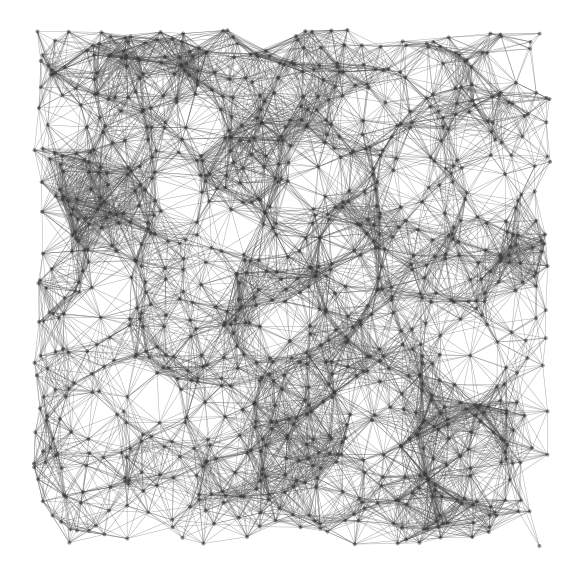Documentation / Generators
Random Euclidean graph generator
This generator creates random graphs of any size. Links of such graphs are created according to a threshold. If the Euclidean distance between two nodes is less than a given threshold, then a link is created between those 2 nodes.

Usage
Calling begin() put one unique node in the graph, then
nextEvents() will add a new node each time it is called and connect
this node to its neighbors according to the threshold planar Euclidean
distance.
This generator has the ability to add randomly chosen numerical values on arbitrary attributes on edges or nodes of the graph, and to randomly choose a direction for edges.
A list of attributes can be given for nodes and edges. In this case each new node or edge added will have this attribute and the value will be a randomly chosen number. The range in which these numbers are chosen can be specified.
By default, edges are not oriented. It is possible to ask orientation, in which case the direction is chosen randomly.
By default, the graph is generated in the plane (2 dimensions) . Cartesian
coordinates on nodes will be generated at random. So, each node will
automatically be given two attributes: x and y. If a dimension is
specified, then dimension attributes are generated, and the 2-norm distance Euclidean distance) is considered in that dimension between the nodes.
If the dimension is 2, then attributes x and y are defined for each node.
If dimension is 3, then attributes x, y and z are used. For other
values of dimension, dimension attributes are defined (xi with i in
dimension) .
Complexity
For the construction of a n nodes graph, the complexity is about O(n^2).
Example
Here is a simple example of use:
Graph graph = new SingleGraph("random euclidean");
Generator gen = new RandomEuclideanGenerator();
gen.addSink(graph);
gen.begin();
for(int i=0; i<1000; i++) {
gen.nextEvents();
}
gen.end();
graph.display(false);